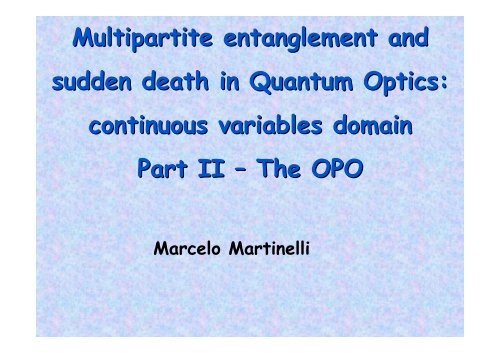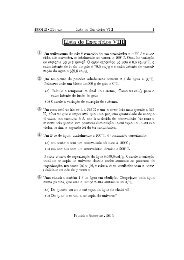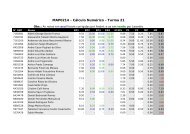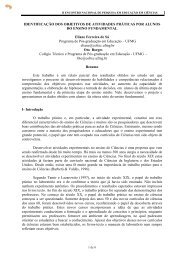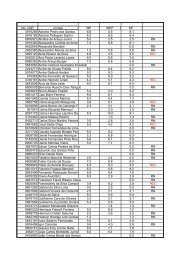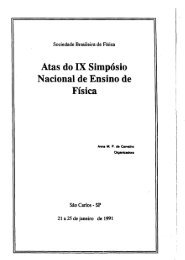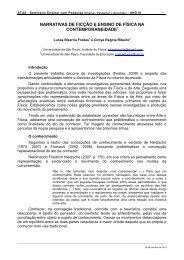Optical Parametric Oscillator (OPO) - Axpfep1.if.usp.br
Optical Parametric Oscillator (OPO) - Axpfep1.if.usp.br
Optical Parametric Oscillator (OPO) - Axpfep1.if.usp.br
You also want an ePaper? Increase the reach of your titles
YUMPU automatically turns print PDFs into web optimized ePapers that Google loves.
Multipartite entanglement andsudden death in Quantum Optics:continuous variables domainPart II – The <strong>OPO</strong>Marcelo Martinelli
Question:Dividing the incident beam in two “equal” parts, what will be the result?WPBSi 1?i 2-i sub
Answer:WPBSi 1?i 2 i-subMedidaClassically: i sub= 0Quantically: “photons are clicks on photodetectors” (A. Zeilinger)= 0, ∆ 2 i sub > 0 !
Quantum Optics – Measurement of the Intense FieldWe can easily measure photon flux: optical powerÊbacd
Building an Interferometer – The Beam Splitter±bˆD2ĉBSdˆD1Homodyning if
“Classical” VarianceShot noise !Vacuum Homodyning allows the cali<strong>br</strong>ation of the detection, producing a Poissoniandistribution in the output (just like a coherent state).
<strong>Parametric</strong> Down ConversionEnergy and momentum conservationω 0 = ω 1 + ω 2k 0 =k 1 +k 2Polarization and transverse momentum correlations
<strong>Optical</strong> <strong>Parametric</strong> <strong>Oscillator</strong>PDC + CavitySignalPumpk 0 ,ω 0α 0in(t)χ (2)α 1out(t)α 2out(t)Idlerk 1 ,ω 1k 2 ,ω 2
<strong>Optical</strong> <strong>Parametric</strong> <strong>Oscillator</strong> (<strong>OPO</strong>)
<strong>Optical</strong> <strong>Parametric</strong> <strong>Oscillator</strong>PDC + CavityPumpk 0 ,ω 0α 1out(t)Signalk 1 ,ω 1α 0in(t)χ (2)α 2out(t)Idlerk 2 ,ω 2Twin photons + phase correlation- Sub-thresholdsqueezed vacuum (degenerate case) - OPAentangled fields (non-degenerate case)- Above threshold: intense entangled fields
<strong>Optical</strong> <strong>Parametric</strong> <strong>Oscillator</strong> (<strong>OPO</strong>) - ClassicalLet us describe classical properties of the system before weanalyze quantum properties. We’ll consider a Triply Resonant<strong>OPO</strong> (TR-<strong>OPO</strong>) in a ring cavity (for simplicity).α 0inα 1outα 0outα 2outr 0r 1r 2R=1lR=1If we consider that the single pass gain issmall, we can approximate the equations forthe amplification inside the crystal
<strong>Optical</strong> <strong>Parametric</strong> <strong>Oscillator</strong> (<strong>OPO</strong>) - Classicalα 0inα 1outα 0outα 2outr 0r 1r 2R=1lR=1Consistency of the field for a round trip gives us
<strong>Optical</strong> <strong>Parametric</strong> <strong>Oscillator</strong> (<strong>OPO</strong>) - ClassicalIf δϕ j is small, we can write:where the total loss foreach mode is definedNormalizing the detuning, wehave
<strong>Optical</strong> <strong>Parametric</strong> <strong>Oscillator</strong> (<strong>OPO</strong>) - ClassicalA first solution of these equations is α 1 = α 2 = 0,corresponding to operation below threshold. We are moreinterested in above-threshold operation. Multiplying thecomplex conjugate of the third equation by the second, wehave:The intracavity pump power is easily obtained and we see itis “clipped”: above-threshold it is always the sameBesides, for , we also haveThe classical equations are already signaling that the intensitiesof signal and idler beams should be strongly correlated and thatthe pump must be depleted.
<strong>Optical</strong> <strong>Parametric</strong> <strong>Oscillator</strong> (<strong>OPO</strong>) - Classical1,00,80,60,40,20,0-2 0 2
<strong>Optical</strong> <strong>Parametric</strong> <strong>Oscillator</strong> (<strong>OPO</strong>) - Classical
<strong>Optical</strong> <strong>Parametric</strong> <strong>Oscillator</strong> (<strong>OPO</strong>) - Classical1,00,80,60,40,20,0-2 0 2
<strong>Optical</strong> <strong>Parametric</strong> <strong>Oscillator</strong> (<strong>OPO</strong>) - ClassicalFrom the first equation we can derive the threshold power,given the intracavity pump field (α 1 = α 2 = 0)An important parameter will be the ratio of incident power tothreshold power on resonance:Substituting α 2 in the first equation, we have
<strong>Optical</strong> <strong>Parametric</strong> <strong>Oscillator</strong> (<strong>OPO</strong>) - ClassicalSinceandWe getSolving for α j
<strong>Optical</strong> <strong>Parametric</strong> <strong>Oscillator</strong> (<strong>OPO</strong>) - ClassicalThis gives the photon flux. Considering, for the sake of theargument, the frequency-degenerate case (ω 1 =ω 2 =ω 0 /2), wecan obtain the total output power and the efficiencyWhere η max is the maximum efficiency leading toWe will see that the parameter ξ determines the maximumsqueezing in the above-threshold <strong>OPO</strong>.
<strong>Optical</strong> <strong>Parametric</strong> <strong>Oscillator</strong> (<strong>OPO</strong>) - QuantumRest of the Universeα 0inα 1outα 0outα 2outr 0r 1r 2R=1lR=1
<strong>Optical</strong> <strong>Parametric</strong> <strong>Oscillator</strong> (<strong>OPO</strong>) – Master EquationEvolution of the density operatorSystem + Reservoir + InteractionEvolution of an operator acting only on the system:Master Equation: Evolution of ρ s
Quantum Properties of the <strong>OPO</strong>Hamiltonian and the master equation:OK, simpler now?We can improve this if we change from the density matrix into an equivalentrepresentation: it will replace (ordering sensitive) operators by c-numbers.But the nonclassicallity makes P representation a tricky choice...
Quasi-Probability RepresentationsP‐ Glauber ‐ SudarshanWigner
Wigner RepresentationEvident quantum/ classical frontierSqueezed statesYStates with W
Quantum Properties of the <strong>OPO</strong>The operators are replaced by amplitudesand the density operator is replaced byUsing the rules
Quantum Properties of the <strong>OPO</strong>We obtainFokker-Planck equation
Quantum Properties of the <strong>OPO</strong>Which is equivalent to a set of Langevin equations(Do you remember the Brownian Motion ?)The mean values in steady state are the same as in the classicaltreatment.Since we will (typically) deal with intense fields, we proceed bylinearizing the fluctuations, neglecting products of fluctuating terms:
Quantum Properties of the <strong>OPO</strong>
Quantum Properties of the <strong>OPO</strong>DefiningWe getwith
Quantum Properties of the <strong>OPO</strong>The subspace related to the subtraction of the fields decouples fromthe sum and the pump fluctuations. However, q - does not have anydecay term, thus the solutions are not strictly stable. As a matter offact, there is phase diffusion and the subtraction of the phases isunbounded. Nevertheless, this is a slow process and we will beinterested in measuring phases with respect to the phase of themean field (in other words, we will follow “adiabatically” the diffusion).Instead of solving these equations in the time domain, we look in thefrequency domain.


